Laws Impacting Amazon in Australia and US
35 Pages12251 Words131 Views
Added on 2023-06-14
About This Document
This article discusses the laws impacting Amazon's business in Australia and the US, including contract, property, tort, insolvency, consumer, competition, labour, and taxation laws. It also covers the legal systems of both countries and the different business structures available in Australia.
Laws Impacting Amazon in Australia and US
Added on 2023-06-14
ShareRelated Documents
qwertyuiopasdfghjklzxcvbnmqwertyui
opasdfghjklzxcvbnmqwertyuiopasdfgh
jklzxcvbnmqwertyuiopasdfghjklzxcvb
nmqwertyuiopasdfghjklzxcvbnmqwer
tyuiopasdfghjklzxcvbnmqwertyuiopas
dfghjklzxcvbnmqwertyuiopasdfghjklzx
cvbnmqwertyuiopasdfghjklzxcvbnmq
wertyuiopasdfghjklzxcvbnmqwertyuio
pasdfghjklzxcvbnmqwertyuiopasdfghj
Contemporary Business Law
Laws which impact Amazon in Australia and US
10-Apr-18
(Student Details: )
opasdfghjklzxcvbnmqwertyuiopasdfgh
jklzxcvbnmqwertyuiopasdfghjklzxcvb
nmqwertyuiopasdfghjklzxcvbnmqwer
tyuiopasdfghjklzxcvbnmqwertyuiopas
dfghjklzxcvbnmqwertyuiopasdfghjklzx
cvbnmqwertyuiopasdfghjklzxcvbnmq
wertyuiopasdfghjklzxcvbnmqwertyuio
pasdfghjklzxcvbnmqwertyuiopasdfghj
Contemporary Business Law
Laws which impact Amazon in Australia and US
10-Apr-18
(Student Details: )

Contemporary Business Law
Table of Contents
Introduction......................................................................................................................................4
Basis of Law/ Legal System............................................................................................................5
Australia.......................................................................................................................................5
U.S...............................................................................................................................................6
Business Structures..........................................................................................................................7
Australia.......................................................................................................................................7
U.S.............................................................................................................................................10
Insolvency......................................................................................................................................10
Australia.....................................................................................................................................10
U.S.............................................................................................................................................11
Consumer Law and Competition Law...........................................................................................12
Australia.....................................................................................................................................12
U.S.............................................................................................................................................15
Labour Law....................................................................................................................................17
Australia.....................................................................................................................................17
U.S.............................................................................................................................................17
Taxation Law.................................................................................................................................18
Australia.....................................................................................................................................18
U.S.............................................................................................................................................19
Page 2
Table of Contents
Introduction......................................................................................................................................4
Basis of Law/ Legal System............................................................................................................5
Australia.......................................................................................................................................5
U.S...............................................................................................................................................6
Business Structures..........................................................................................................................7
Australia.......................................................................................................................................7
U.S.............................................................................................................................................10
Insolvency......................................................................................................................................10
Australia.....................................................................................................................................10
U.S.............................................................................................................................................11
Consumer Law and Competition Law...........................................................................................12
Australia.....................................................................................................................................12
U.S.............................................................................................................................................15
Labour Law....................................................................................................................................17
Australia.....................................................................................................................................17
U.S.............................................................................................................................................17
Taxation Law.................................................................................................................................18
Australia.....................................................................................................................................18
U.S.............................................................................................................................................19
Page 2
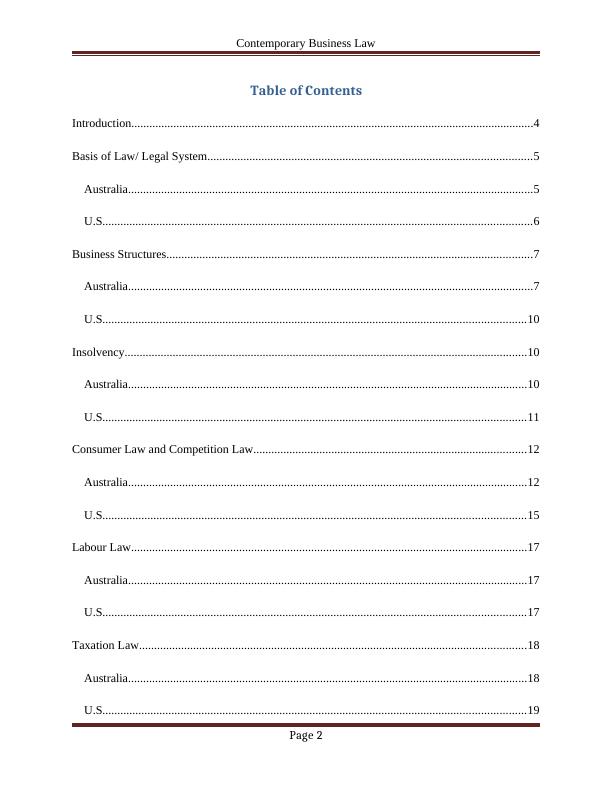
Contemporary Business Law
Law of Property.............................................................................................................................20
Australia.....................................................................................................................................20
U.S.............................................................................................................................................21
Tort of Negligence.........................................................................................................................21
Australia.....................................................................................................................................22
U.S.............................................................................................................................................24
Contract Law.................................................................................................................................24
Australia.....................................................................................................................................24
U.S.............................................................................................................................................26
Conclusion.....................................................................................................................................27
Bibliography..................................................................................................................................28
Articles/ Books/ Journals...........................................................................................................28
Cases..........................................................................................................................................30
Legislations................................................................................................................................30
Others.........................................................................................................................................32
Page 3
Law of Property.............................................................................................................................20
Australia.....................................................................................................................................20
U.S.............................................................................................................................................21
Tort of Negligence.........................................................................................................................21
Australia.....................................................................................................................................22
U.S.............................................................................................................................................24
Contract Law.................................................................................................................................24
Australia.....................................................................................................................................24
U.S.............................................................................................................................................26
Conclusion.....................................................................................................................................27
Bibliography..................................................................................................................................28
Articles/ Books/ Journals...........................................................................................................28
Cases..........................................................................................................................................30
Legislations................................................................................................................................30
Others.........................................................................................................................................32
Page 3

Contemporary Business Law
Introduction
Amazon.com. Inc., otherwise simply referred to as Amazon is the US based cloud computing
and electronic commerce company, which is headquartered at Seattle, Washington. The company
was established on 05th July, 1994 by Jeff Bezo1s. In a short span, the company became the
largest internet retailer across the globe in terms of market capitalization and revenue. It comes
just second when it comes to the sales figures2. The company had initially started itself as an
online bookstore but it went on to diversify itself in downloading and streaming of videos, MP3s,
audio books, and went forth with its entering streams like food, toys, furniture, jewellery,
apparel, electronics, video games and software. Amazon also produces the consumer electronics
like Echo, Fire TV, Fire tablets, and the most famous Kindle e-reader, along with providing
cloud infrastructure services. Amazon is often taken as a seller of low end products due to its in
house brand of AmazonBasics3.
Amazon is truly a global company and has its operations spread across the globe. It also caters to
different nations by bringing forth different retail websites for UK, US, Ireland, Spain, Italy,
Germany, Canada, France, Australia, Brazil, India, Mexico, Japan and China. It goes beyond the
international boundaries to ship products in varied nations. Due to the large scale of operations of
Amazon, spread across the globe, the laws of different nations, where Amazon conducts its
business, are applied on the company4. These include the laws of contract, property tort,
insolvency, consumer, competition, labour and taxation. There are certain laws which are similar
in the nations and then there are laws which differentiate on varied basis. This discussion aims at
highlighting the different laws which apply on the business of Amazon, particularly when they
conduct business in Australia and US.
1 Tom Robinson, Jeff Bezos: Amazon.com Architect (ABDO, 2009)
2 Nancy Richter, Paul Jackson and Thomas Schildhauer, Entrepreneurial Innovation and Leadership: Preparing for
a Digital Future (Springer, 2018)
3 Amazon, Echo, Fire Tablet, Kindle E-reader, & Fire TV Accessories (2018) <https://www.amazon.com/Kindle-
Accessories-Electronics/b?ie=UTF8&node=370783011>
4 Erika Wittekind, Amazon.com: The Company and Its Founder: The Company and Its Founder (ABDO, 2012)
Page 4
Introduction
Amazon.com. Inc., otherwise simply referred to as Amazon is the US based cloud computing
and electronic commerce company, which is headquartered at Seattle, Washington. The company
was established on 05th July, 1994 by Jeff Bezo1s. In a short span, the company became the
largest internet retailer across the globe in terms of market capitalization and revenue. It comes
just second when it comes to the sales figures2. The company had initially started itself as an
online bookstore but it went on to diversify itself in downloading and streaming of videos, MP3s,
audio books, and went forth with its entering streams like food, toys, furniture, jewellery,
apparel, electronics, video games and software. Amazon also produces the consumer electronics
like Echo, Fire TV, Fire tablets, and the most famous Kindle e-reader, along with providing
cloud infrastructure services. Amazon is often taken as a seller of low end products due to its in
house brand of AmazonBasics3.
Amazon is truly a global company and has its operations spread across the globe. It also caters to
different nations by bringing forth different retail websites for UK, US, Ireland, Spain, Italy,
Germany, Canada, France, Australia, Brazil, India, Mexico, Japan and China. It goes beyond the
international boundaries to ship products in varied nations. Due to the large scale of operations of
Amazon, spread across the globe, the laws of different nations, where Amazon conducts its
business, are applied on the company4. These include the laws of contract, property tort,
insolvency, consumer, competition, labour and taxation. There are certain laws which are similar
in the nations and then there are laws which differentiate on varied basis. This discussion aims at
highlighting the different laws which apply on the business of Amazon, particularly when they
conduct business in Australia and US.
1 Tom Robinson, Jeff Bezos: Amazon.com Architect (ABDO, 2009)
2 Nancy Richter, Paul Jackson and Thomas Schildhauer, Entrepreneurial Innovation and Leadership: Preparing for
a Digital Future (Springer, 2018)
3 Amazon, Echo, Fire Tablet, Kindle E-reader, & Fire TV Accessories (2018) <https://www.amazon.com/Kindle-
Accessories-Electronics/b?ie=UTF8&node=370783011>
4 Erika Wittekind, Amazon.com: The Company and Its Founder: The Company and Its Founder (ABDO, 2012)
Page 4

Contemporary Business Law
Basis of Law/ Legal System
Legal system of any nation refer to the procedures and processes which are made use of, for the
purpose of interpreting and enforcing different legislations or laws. Based on the different
jurisdictions and ideologies, different legal systems exist5. In order to conduct business in any
nation, it is important for the companies to be clear on what exactly the legal system of such
nation is. All these laws of the two nations have to be kept at the centre by Amazon to be an
example of corporate citizen.
Australia
In Australia, there exists a parliamentary democracy6. The constitution of the nation had been
established in 1901 as a federal system of government. This system provides that the powers
have to be distributed in between the national government, which is otherwise referred to as the
Commonwealth, and the six states in the nation. Apart from the six states in the nation, there are
three self-governing territories. The boundaries of law making in between the state/ territories
and the commonwealth are defined by the constitution of the nation7. At the time of colonisation,
Australia inherited the legal system, which is a common law system, from England. There are
two major sources of laws in the nation, which includes the statutes, and the cases. The statutes
or the legislations are the legal rules which the parliament makes and these are the ones through
which the parliament gets delegated authority. The other source of cases refers to the decisions
which are made by the judges in courts, which are otherwise referred to as the precedents8.
There is a division of powers in the nation, whereby the functions of government are divided
under legislative, executive and judicial. This doctrine of separation of powers is meant to keep
checks and balances where one institution is given a single power, and the functioning of one
branch is not to be interfered with, by the other branch9. There are a number of basis on which
the law in the nation is divided, one of which is the civil and criminal branches of law. The civil
5 US Legal, Legal System Law and Legal Definition (2018) <https://definitions.uslegal.com/l/legal-system/>
6 Australian National University, The Australian Legal System (2018) <http://libguides.anu.edu.au/c.php?
g=634887&p=4547083>
7 Nicholas Aroney, The Constitution of a Federal Commonwealth: The Making and Meaning of the Australian
Constitution (Cambridge University Press, 2009)
8 John Carvan, Understanding the Australian Legal System (Lawbook Company, 2009)
9 Roger Masterman, The Separation of Powers in the Contemporary Constitution: Judicial Competence and
Independence in the United Kingdom (Cambridge University Press, 2010)
Page 5
Basis of Law/ Legal System
Legal system of any nation refer to the procedures and processes which are made use of, for the
purpose of interpreting and enforcing different legislations or laws. Based on the different
jurisdictions and ideologies, different legal systems exist5. In order to conduct business in any
nation, it is important for the companies to be clear on what exactly the legal system of such
nation is. All these laws of the two nations have to be kept at the centre by Amazon to be an
example of corporate citizen.
Australia
In Australia, there exists a parliamentary democracy6. The constitution of the nation had been
established in 1901 as a federal system of government. This system provides that the powers
have to be distributed in between the national government, which is otherwise referred to as the
Commonwealth, and the six states in the nation. Apart from the six states in the nation, there are
three self-governing territories. The boundaries of law making in between the state/ territories
and the commonwealth are defined by the constitution of the nation7. At the time of colonisation,
Australia inherited the legal system, which is a common law system, from England. There are
two major sources of laws in the nation, which includes the statutes, and the cases. The statutes
or the legislations are the legal rules which the parliament makes and these are the ones through
which the parliament gets delegated authority. The other source of cases refers to the decisions
which are made by the judges in courts, which are otherwise referred to as the precedents8.
There is a division of powers in the nation, whereby the functions of government are divided
under legislative, executive and judicial. This doctrine of separation of powers is meant to keep
checks and balances where one institution is given a single power, and the functioning of one
branch is not to be interfered with, by the other branch9. There are a number of basis on which
the law in the nation is divided, one of which is the civil and criminal branches of law. The civil
5 US Legal, Legal System Law and Legal Definition (2018) <https://definitions.uslegal.com/l/legal-system/>
6 Australian National University, The Australian Legal System (2018) <http://libguides.anu.edu.au/c.php?
g=634887&p=4547083>
7 Nicholas Aroney, The Constitution of a Federal Commonwealth: The Making and Meaning of the Australian
Constitution (Cambridge University Press, 2009)
8 John Carvan, Understanding the Australian Legal System (Lawbook Company, 2009)
9 Roger Masterman, The Separation of Powers in the Contemporary Constitution: Judicial Competence and
Independence in the United Kingdom (Cambridge University Press, 2010)
Page 5
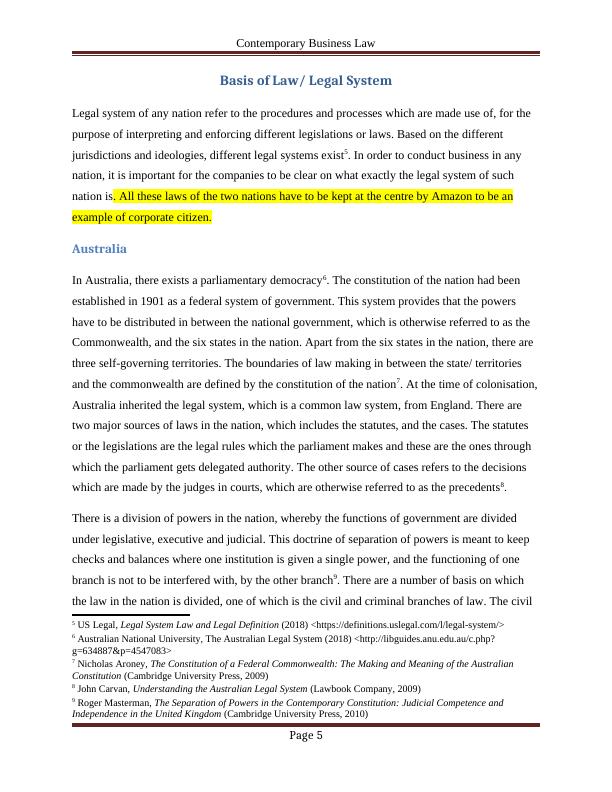
Contemporary Business Law
law includes the cases where the instances are not serious in nature, and include instances of
tortious acts like negligence. In comparison to civil law, the criminal law covers instances like
manslaughter and murder, where the aim is to punish the guilty. In doing so, certain requirements
like showing mens rea are required10. With these separations and demarcations, the efficiency of
the law is enhanced. The separation of law further ensures that there is specialization and
efficiency in the varied fields and aspects of law.
U.S.
As is the case in Australia, in US also, the legal system covers the federal and state governmental
divisions. However, there is a lot more complexity involved in the legal system of US. For
gaining a proper understanding of the legal system of US, there is a need to understand which
rules, regulations or laws are applicable. Basically, there is a need to understand the laws which
have a controlling effect or priority in the nation. In US, the constitution of the nation is the
highest law of land11. The US Congress enacts the Federal Laws which come next in hierarchy.
However, this does not infer that Federal Congress can adopt laws which control the states in
every situation. This cannot be done till the time the law can be applied to the states based on the
precedents and the US Constitution. Each state in US has a legislature where the state laws are
adopted and are referred to as the statutes. These statutes are often complied in what is
commonly referred to as a Code. This is basically just a codification of the applicable statutes12.
There are a number of other similarities in between the legal systems of the two nations. Both the
nations have adopted the doctrine of separation, where the powers are divided in between
executive, judiciary and legislative branches. There is also the bifurcation of laws on the basis of
civil and criminal jurisdictions. There is also a commonality in terms of law having two sources
of court cases and statues13.
10 Linda E. Carter and Fausto Pocar, International Criminal Procedure: The Interface of Civil Law and Common
Law Legal Systems (Edward Elgar, 2013)
11 Jenna Ellis Esq., The Legal Basis for a Moral Constitution: A Guide for Christians to Understand America's
Constitutional Crisis (WestBow Press 2015)
12 US Legal, US Legal System (2018) <https://system.uslegal.com/>
13 Find Law, The U.S. Legal System (2018) <http://corporate.findlaw.com/litigation-disputes/the-u-s-legal-
system.html>
Page 6
law includes the cases where the instances are not serious in nature, and include instances of
tortious acts like negligence. In comparison to civil law, the criminal law covers instances like
manslaughter and murder, where the aim is to punish the guilty. In doing so, certain requirements
like showing mens rea are required10. With these separations and demarcations, the efficiency of
the law is enhanced. The separation of law further ensures that there is specialization and
efficiency in the varied fields and aspects of law.
U.S.
As is the case in Australia, in US also, the legal system covers the federal and state governmental
divisions. However, there is a lot more complexity involved in the legal system of US. For
gaining a proper understanding of the legal system of US, there is a need to understand which
rules, regulations or laws are applicable. Basically, there is a need to understand the laws which
have a controlling effect or priority in the nation. In US, the constitution of the nation is the
highest law of land11. The US Congress enacts the Federal Laws which come next in hierarchy.
However, this does not infer that Federal Congress can adopt laws which control the states in
every situation. This cannot be done till the time the law can be applied to the states based on the
precedents and the US Constitution. Each state in US has a legislature where the state laws are
adopted and are referred to as the statutes. These statutes are often complied in what is
commonly referred to as a Code. This is basically just a codification of the applicable statutes12.
There are a number of other similarities in between the legal systems of the two nations. Both the
nations have adopted the doctrine of separation, where the powers are divided in between
executive, judiciary and legislative branches. There is also the bifurcation of laws on the basis of
civil and criminal jurisdictions. There is also a commonality in terms of law having two sources
of court cases and statues13.
10 Linda E. Carter and Fausto Pocar, International Criminal Procedure: The Interface of Civil Law and Common
Law Legal Systems (Edward Elgar, 2013)
11 Jenna Ellis Esq., The Legal Basis for a Moral Constitution: A Guide for Christians to Understand America's
Constitutional Crisis (WestBow Press 2015)
12 US Legal, US Legal System (2018) <https://system.uslegal.com/>
13 Find Law, The U.S. Legal System (2018) <http://corporate.findlaw.com/litigation-disputes/the-u-s-legal-
system.html>
Page 6
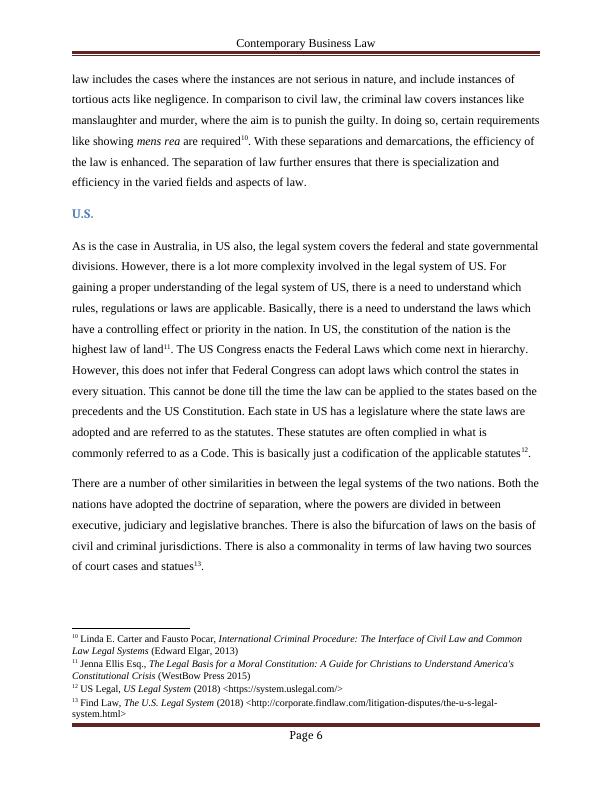
Contemporary Business Law
Business Structures
Each nation has different business structures, through which the business can be conducted by
the organizations. Before entering in any nation, or even to run and expand the business, the
division of business structure becomes very crucial. When conducting business in US and
Australia, Amazon needs to carefully evaluate these structures, and adopt the structure which
best suits their needs.
Australia
Australia has majorly four distinctive business structures, which can be adopted for conducting
business in the nation. These include sole trader, company, trust and partnership14. Each of these
structures comes with their set of unique features and reasons to be adopted or to be skipped
over. There are some other structures as well in the nation which are incorporate associations and
joint venture15.
A sole trader is the easiest form of business structure in the nation, where a person conducts their
business in an independent manner and has the responsibility for every aspect of the business.
This model is also the least expensive model, coupled with minimal regulatory requirements16.
The responsibility in case of sol trader is with the person who owns the business, and this
responsibility is for debts and losses suffered by the businesses. The business name of the sole
trader is to be registered with the ASIC, i.e. Australian Securities and Investments Commissions,
based on the provisions of the Business Names Registration Act, 2011 (Cth)17. The sole trader
form is not treated separately from the owner.
Just because the business is run by a single person, does not mean that other people cannot be
hired in to do the work. The sole trader can employ people, so long as they are provided with
superannuation, compensation insurance for workers and payroll tax. The taxes of the business
can be clubbed up with personal taxes, and can be paid under Tax File Number of the
14 Australian Government, Business structure (2018) <https://www.business.gov.au/info/plan-and-start/start-your-
business/business-structure>
15 Paul Latimer, Australian Business Law 2012 (CCH Australia Limited, 31st ed, 2012)
16 Veechi Curtis, Getting Started In Small Business For Dummies (John Wiley & Sons, 3rd ed., 2016)
17 Business Names Registration Act, 2011 (Cth)
Page 7
Business Structures
Each nation has different business structures, through which the business can be conducted by
the organizations. Before entering in any nation, or even to run and expand the business, the
division of business structure becomes very crucial. When conducting business in US and
Australia, Amazon needs to carefully evaluate these structures, and adopt the structure which
best suits their needs.
Australia
Australia has majorly four distinctive business structures, which can be adopted for conducting
business in the nation. These include sole trader, company, trust and partnership14. Each of these
structures comes with their set of unique features and reasons to be adopted or to be skipped
over. There are some other structures as well in the nation which are incorporate associations and
joint venture15.
A sole trader is the easiest form of business structure in the nation, where a person conducts their
business in an independent manner and has the responsibility for every aspect of the business.
This model is also the least expensive model, coupled with minimal regulatory requirements16.
The responsibility in case of sol trader is with the person who owns the business, and this
responsibility is for debts and losses suffered by the businesses. The business name of the sole
trader is to be registered with the ASIC, i.e. Australian Securities and Investments Commissions,
based on the provisions of the Business Names Registration Act, 2011 (Cth)17. The sole trader
form is not treated separately from the owner.
Just because the business is run by a single person, does not mean that other people cannot be
hired in to do the work. The sole trader can employ people, so long as they are provided with
superannuation, compensation insurance for workers and payroll tax. The taxes of the business
can be clubbed up with personal taxes, and can be paid under Tax File Number of the
14 Australian Government, Business structure (2018) <https://www.business.gov.au/info/plan-and-start/start-your-
business/business-structure>
15 Paul Latimer, Australian Business Law 2012 (CCH Australia Limited, 31st ed, 2012)
16 Veechi Curtis, Getting Started In Small Business For Dummies (John Wiley & Sons, 3rd ed., 2016)
17 Business Names Registration Act, 2011 (Cth)
Page 7
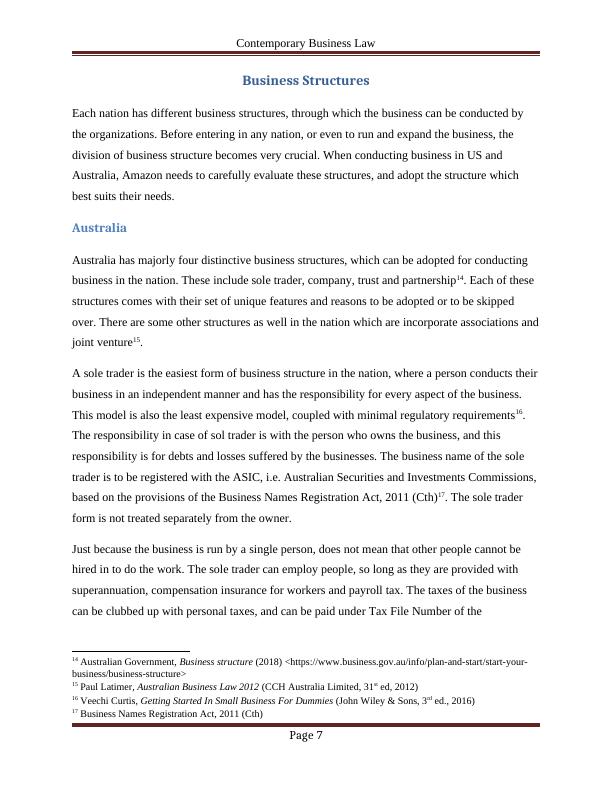
Contemporary Business Law
individual18. However, the sole traders have unlimited liability. This means that for the debts of
the sole trader, the personal assets of the sole trader can be attached. But this form brings with it
a level of simplicity and flexibility which makes it as the structure of choice for a number of
businesses19.
The next business structure form is partnership. A partnership can be created when two or more
individuals, up to a limit of twenty people, come together to run a business with common
purpose, for earning profits. The partnership can be formed where the features of a partnership
are met, even when the same are not reduced into writing in a partnership deed, as it is not an
obligatory document20. Each jurisdiction in Australia has a different partnership act. For instance,
in New South Wales, the Partnership Act, 189221 is applicable. There is equal responsibility
under the partnership, whereby the partners are jointly and severally liable for the debts of the
firm. There is applicability of agency law on partnership, which make all the partners binding to
one another. Again, this is a relatively easier and inexpensive mode of setting up a business.
However, instances like quarrels and fights can run in partnership ending. There is also the con
of unlimited liability amongst the partners22.
The most common form of running business in Australia is the corporations form. Under this
form, the business is run by the management on behalf of the shareholders. The companies in
Australia are governed by the Corporations Act, 200123 and are regulated by the ASIC. As
against the business structures of partnership and sole trader, the company is deemed as a
separate legal entity. This means that for the debts of the company, the shareholders cannot be
made liable. They can only be made liable in the event of company being wound up, where they
have any unpaid amount left on the shares. Beyond that, they cannot be made liable. The
directors of the company run the daily operations24.
18 Department of Industry, Innovation and Science, Sole trader (7 June 2017)
<https://www.business.gov.au/info/plan-and-start/start-your-business/business-structure/business-structures-and-
types/sole-trader>
19 Roger Vickery and MaryAnne Flood, Australian business law: compliance and practice (Pearson Australia, 2012)
20 Joseph Story, Commentaries on the Law of Partnership, as a Branch of Commercial and Maritime Jurisprudence,
with Occasional Illustrations from the Civil and Foreign Law (The Lawbook Exchange, Ltd., 2007)
21 Partnership Act, 1892 (NSW)
22 Andy Gibson and Douglas Fraser, Business Law (Pearson Higher Education AU, 2013)
23 Corporations Act, 2001 (Cth)
24 Phillip Lipton, Abe Herzberg, and Michelle Welsh, Understanding Company Law (Thomson Reuters, 18th ed,
2016)
Page 8
individual18. However, the sole traders have unlimited liability. This means that for the debts of
the sole trader, the personal assets of the sole trader can be attached. But this form brings with it
a level of simplicity and flexibility which makes it as the structure of choice for a number of
businesses19.
The next business structure form is partnership. A partnership can be created when two or more
individuals, up to a limit of twenty people, come together to run a business with common
purpose, for earning profits. The partnership can be formed where the features of a partnership
are met, even when the same are not reduced into writing in a partnership deed, as it is not an
obligatory document20. Each jurisdiction in Australia has a different partnership act. For instance,
in New South Wales, the Partnership Act, 189221 is applicable. There is equal responsibility
under the partnership, whereby the partners are jointly and severally liable for the debts of the
firm. There is applicability of agency law on partnership, which make all the partners binding to
one another. Again, this is a relatively easier and inexpensive mode of setting up a business.
However, instances like quarrels and fights can run in partnership ending. There is also the con
of unlimited liability amongst the partners22.
The most common form of running business in Australia is the corporations form. Under this
form, the business is run by the management on behalf of the shareholders. The companies in
Australia are governed by the Corporations Act, 200123 and are regulated by the ASIC. As
against the business structures of partnership and sole trader, the company is deemed as a
separate legal entity. This means that for the debts of the company, the shareholders cannot be
made liable. They can only be made liable in the event of company being wound up, where they
have any unpaid amount left on the shares. Beyond that, they cannot be made liable. The
directors of the company run the daily operations24.
18 Department of Industry, Innovation and Science, Sole trader (7 June 2017)
<https://www.business.gov.au/info/plan-and-start/start-your-business/business-structure/business-structures-and-
types/sole-trader>
19 Roger Vickery and MaryAnne Flood, Australian business law: compliance and practice (Pearson Australia, 2012)
20 Joseph Story, Commentaries on the Law of Partnership, as a Branch of Commercial and Maritime Jurisprudence,
with Occasional Illustrations from the Civil and Foreign Law (The Lawbook Exchange, Ltd., 2007)
21 Partnership Act, 1892 (NSW)
22 Andy Gibson and Douglas Fraser, Business Law (Pearson Higher Education AU, 2013)
23 Corporations Act, 2001 (Cth)
24 Phillip Lipton, Abe Herzberg, and Michelle Welsh, Understanding Company Law (Thomson Reuters, 18th ed,
2016)
Page 8
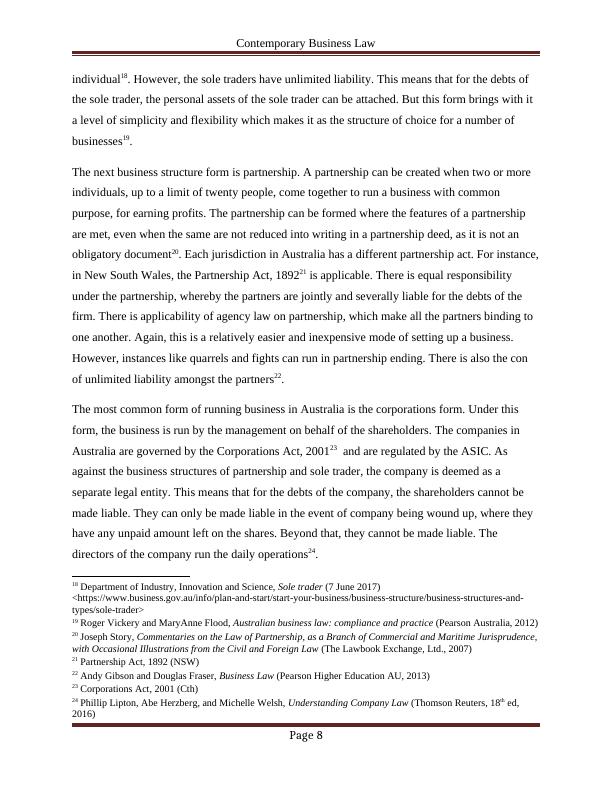
End of preview
Want to access all the pages? Upload your documents or become a member.
Related Documents
Strategic Marketing: Top-Down vs Outside-In Approach and Amazon's Marketing Strategieslg...
|29
|6715
|300
Analysis of Motivational Strategies in Amazon for Effective Operations in Retail Industrylg...
|10
|3069
|165
Analysis of the Marketing Assignmentlg...
|28
|7279
|51
BUSN412 Strategic Management of Amazon Inc Assignmentlg...
|14
|2521
|229
Marketing Strategies of Amazon Australialg...
|12
|2633
|192
PESTLE and SWOT analysis : AMAZONlg...
|20
|4814
|160
